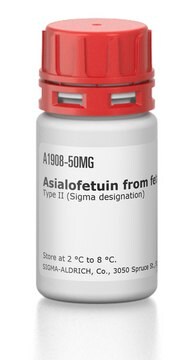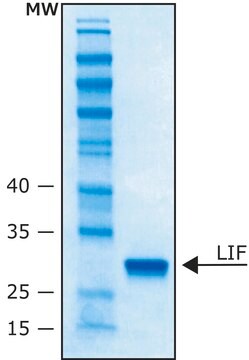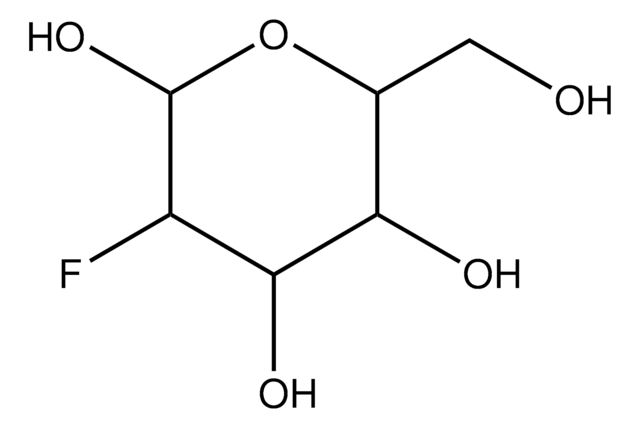Alle Fotos(1)
Wichtige Dokumente
L9277
Anti-Leukemia Inhibitory Factor antibody produced in goat
IgG fraction of antiserum, lyophilized powder
Synonym(e):
Anti-LIF
Anmeldenzur Ansicht organisationsspezifischer und vertraglich vereinbarter Preise
Alle Fotos(1)
About This Item
Empfohlene Produkte
Biologische Quelle
goat
Qualitätsniveau
Konjugat
unconjugated
Antikörperform
IgG fraction of antiserum
Antikörper-Produkttyp
primary antibodies
Klon
polyclonal
Form
lyophilized powder
Speziesreaktivität
human
Methode(n)
neutralization: suitable
UniProt-Hinterlegungsnummer
Lagertemp.
−20°C
Posttranslationale Modifikation Target
unmodified
Angaben zum Gen
human ... LIF(3976)
Allgemeine Beschreibung
Leukemia inhibitory factor (LIF) is a pleotrophic glycoprotein that belongs to the IL6 family of cytokines. It is secreted by many cell types such as, fibroblasts, macrophages, T cells, monocytes, liver cells, osteoblasts and cells of endometrium. LIF interacts with a heterodimeric receptor composed of two subunits, gp130 and gp190. A variety of signal transduction pathways are triggered in response to LIF including ERK/MAPK, JAK1, PI3K, STAT3, Jun-cFos and NF-κB. The various functions of LIF include proliferation of adult human T cells, maintenance of pluripotency of embryonic stem cells and inhibition of leukemic ell differentiation. Reports also indicate the important role of LIF in lactation, tissue regeneration after brain and spinal cord injury, muscle regeneration and motor neuron functions.
Anti-Leukemia Inhibitory Factor recognizes human leukemia inhibitory factor. It shows no cross-reactivity with recombinant mouse LIF.
Anti-Leukemia Inhibitory Factor recognizes human leukemia inhibitory factor. It shows no cross-reactivity with recombinant mouse LIF.
Spezifität
The antibody neutralizes the biological activity of recombinant human LIF.
Immunogen
recombinant human LIF expressed in E. coli
Anwendung
Anti-Leukemia Inhibitory Factor antibody may be for immunoblotting a concentration of 1 μg/ml For ELISA a working concentration of 1 μg/ml is recommended. The antibody is suitable for neutralization reactions. For neutralization of LIF in SEK1, melanoma cell line, a concentration of 100 μg/ml was used.
Physikalische Form
Lyophilized from a 0.2 μm filtered solution in phosphate buffered saline
Angaben zur Herstellung
Purified using protein G
Sie haben nicht das passende Produkt gefunden?
Probieren Sie unser Produkt-Auswahlhilfe. aus.
Ähnliches Produkt
Produkt-Nr.
Beschreibung
Preisangaben
Lagerklassenschlüssel
11 - Combustible Solids
WGK
WGK 3
Flammpunkt (°F)
Not applicable
Flammpunkt (°C)
Not applicable
Persönliche Schutzausrüstung
Eyeshields, Gloves, type N95 (US)
Hier finden Sie alle aktuellen Versionen:
Besitzen Sie dieses Produkt bereits?
In der Dokumentenbibliothek finden Sie die Dokumentation zu den Produkten, die Sie kürzlich erworben haben.
Mikio Tomida et al.
Oncogene, 23(3), 679-686 (2003-12-03)
We found that human melanoma SEKI and neuroepithelioma NAGAI cells, which are known to secrete high concentrations of leukemia inhibitory factor (LIF), also secrete high levels of hepatocyte growth factor (HGF). We therefore examined the role of LIF in HGF
Pin Li et al.
EMBO molecular medicine, 14(1), e14511-e14511 (2021-11-16)
In the course of our studies aiming to discover vascular bed-specific endothelial cell (EC) mitogens, we identified leukemia inhibitory factor (LIF) as a mitogen for bovine choroidal EC (BCE), although LIF has been mainly characterized as an EC growth inhibitor
Ekaterini A Kritikou et al.
Development (Cambridge, England), 130(15), 3459-3468 (2003-06-18)
STAT3 is the key mediator of apoptosis in mammary gland. We demonstrate here that LIF is the physiological activator of STAT3, because in involuting mammary glands of Lif(-/-) mice, pSTAT3 is absent and the STAT3 target, C/EBPdelta, is not upregulated.
Sylvian Bauer et al.
The Journal of neuroscience : the official journal of the Society for Neuroscience, 26(46), 12089-12099 (2006-11-17)
Although neural stem cells (NSCs) persist in various areas of the adult brain, their contribution to brain repair after injury is very limited. Treatment with exogenous growth factors can mitigate this limitation, suggesting that the brain environment is normally deficient
L C Hunt et al.
Experimental cell research, 316(6), 1002-1009 (2009-12-08)
Leukemia inhibitory factor (LIF) is an important regulator of skeletal muscle regeneration and has been suggested to be mitogenic for myogenic cells because it has been shown to increase the quantity of myoblast cells grown in culture over extended periods
Unser Team von Wissenschaftlern verfügt über Erfahrung in allen Forschungsbereichen einschließlich Life Science, Materialwissenschaften, chemischer Synthese, Chromatographie, Analytik und vielen mehr..
Setzen Sie sich mit dem technischen Dienst in Verbindung.



